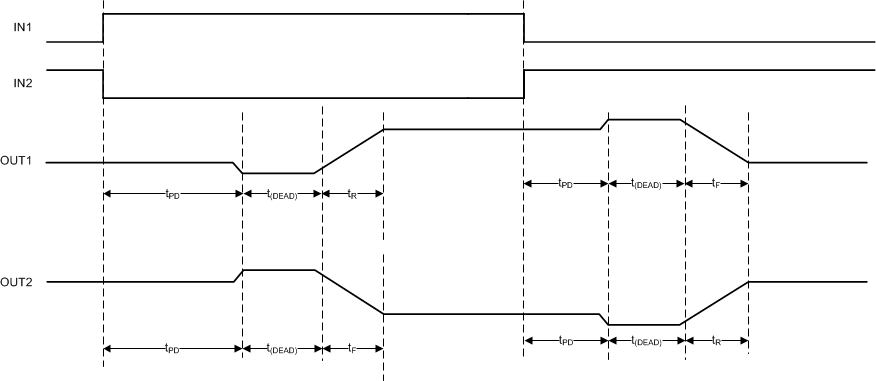ZHCSIO5B October 2017 – January 2021 DRV8873-Q1
PRODUCTION DATA
- 1 特性
- 2 应用
- 3 说明
- 4 Revision History
- 5 Pin Configuration and Functions
- 6 Specifications
-
7 Detailed Description
- 7.1 Overview
- 7.2 Functional Block Diagram
- 7.3 Feature Description
- 7.4 Device Functional Modes
- 7.5 Programming
- 7.6 Register Maps
- 8 Application and Implementation
- 9 Power Supply Recommendations
- 10Layout
- 11Device and Documentation Support
- 12Mechanical, Packaging, and Orderable Information
7.3.1.6 Dead Time
The dead time (t(DEAD)) is measured as the time when the OUTx pin is in the Hi-Z state between turning off one of the half bridge MOSFETs and turning on the other. For example, the output is in the Hi-Z state between turning off the high-side MOSFET and turning on the low-side MOSFET, or turning on the high-side MOSFET and turning off the low-side MOSFET.
 Figure 7-9 Propagation Delay Time
Figure 7-9 Propagation Delay TimeIf the output pin is measured during the tDEAD time the voltage depends on the direction of the current. If the current is leaving the pin, the voltage is a diode drop below ground. If the current is entering the pin, the voltage is a diode drop above VM. The diode drop is associated with the body diode of the high-side or the low-side FET. The dead time is dependent on the slew-rate setting because a portion of the FET gate ramp includes the observable dead time.